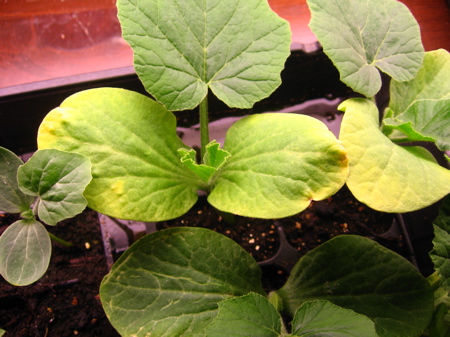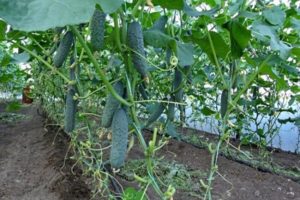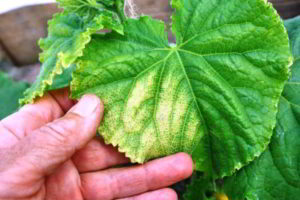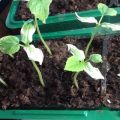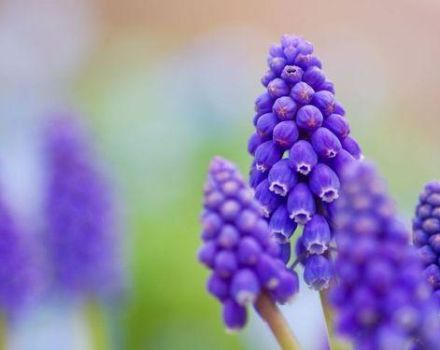Why do cucumber leaves on the windowsill turn yellow and dry and what to do
Cultivation of cucumbers at home is a challenging test for every gardener. Why do the leaves dry on cucumbers living on a veranda or open beds? There are several reasons for this problem. The plant has rich foliage and is constantly evolving, capturing living space.
general information
The main problems that precede yellowing of foliage lie in improper watering, feeding or lighting.
But there are some nuances that need to be considered in more detail:
- Lighting. The plant has dense and wide foliage. In pursuit of sunlight, the lower part is oppressed. Some diseases of cucumbers on the windowsill do occur when there is insufficient lighting. Yellowing and drying of the leaves is the first sign that the plant needs extra care.
- Watering. Insufficient watering leads to disease of seedlings of cucumbers and adult plants. Abundant irrigation should be done at least once a week. When setting and growing fruits, there is an intensive consumption of moisture, which can only be replenished from the soil. There is no need to cure the culture for imaginary diseases. It is enough to organize an effective irrigation schedule and subsequently adhere to the recommendations of specialists.
- Hypothermia. When growing crops in the zone of risky farming, sudden temperature changes are possible. The heat-loving plant does not tolerate the cold test, after which the leaves turn white, and part of the flora dies. The most favorable is a constant temperature regime without sharp fluctuations.
- Nutrition. When examining a crop, gardeners first examine the tops. The lower leaves on cucumbers are a kind of health indicator. The yellowing, wilting and dying off of parts of the plant depend on nutrients. With intensive development, cucumber leaves require elements such as phosphorus, potassium and magnesium.
- Fungal diseases. The culture develops well in greenhouse conditions. Abundant watering provokes the development of soil bacteria, after which the entire culture may become infected. Often, greens are also affected, becoming covered with a grayish-brown bloom. Treatment with a disinfecting solution, for example, Topaz or Quadris, helps. Infected leaves are removed immediately.

- Stressful situations. With a sudden change in weather, a change in temperature or damage to a plant by strong wind, rain or hail, survival mechanisms are triggered - this is why foliage turns yellow in cucumbers. The culture tries to survive and provides food for the most productive parts: tops and fruits.
- End of the season. Cucumbers are an annual plant that aims to grow fruit and plant seeds for the next season.At the end of the life cycle, a gradual yellowing of the foliage occurs, the tops dries up. The cucumbers on the windowsill clearly show this process: first, the lower part of the tops dries up, and in the future - the whole plant.
But what if the leaves of the cucumbers on the windowsill turn yellow and why is this happening?
An effective folk remedy for preventing yellow leaves is a solution of kefir and whey from sour milk. The composition is diluted with water in a ratio of 2:10. The resulting composition is regularly processed with cucumbers.
The effect is achieved due to lactic acid bacteria, which do not harm the culture, but inhibit wild soil bacteria.
A little about fertilizers
So why do cucumber seedlings turn yellow with proper care? Why do the leaves die from this? If the irrigation regime is correctly selected and the temperature conditions correspond to the requirements for growing the variety, then they do not dry out. The problem most likely lies in a lack of nutrients.
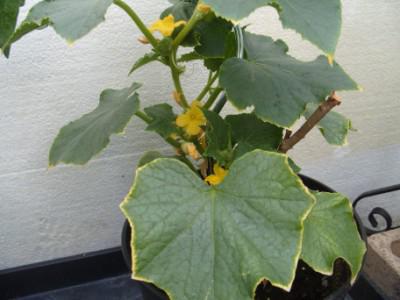
Top dressing is carried out several times per season using mineral and organic fertilizers. If the edges of the leaves begin to turn yellow, this is the first sign that the plant is feeling uncomfortable.
One of the effective grandmother's recipes is mullein infusion. If the leaves dry up, pour 3 liters of warm water over a kilogram of manure and let sit for several days. After that, the solution is filtered and again diluted with water. The resulting liquid is poured over the plants. This method is well suited for feeding: cucumbers on the balcony usually receive more attention than in their summer cottage.
Mineral fertilizers
In organic dressings, some elements are in scanty amounts. With an insufficient amount of minerals in cucumbers, leaves turn yellow and yield decreases. The application of mineral fertilizers is extremely important for the plant diet.
The main elemental composition includes:
- Nitrogen. Here is the answer to the question why the leaves of seedlings dry: it often turns out that due to the lack of nitrogen in the soil. Leaves of cucumber seedlings are sensitive to this element. The best sources of this element are urea, ammonium nitrate and carbamide. An excess of nitrogen in the soil leads to an unreasonable growth of the cucumber crop. A small amount of ovaries is formed, the foliage becomes a juicy dark green color. Even if the leaves dry on the cucumbers on the windowsill, the situation can be corrected with regular watering: the element is simply washed out of the soil with water.
- Phosphorus. Responsible for the formation of the root system and the quality of plant nutrition. With its lack, the leaves of the seedlings turn yellow and a general starvation of the culture is observed. Stem growth slows down, fewer ovaries are formed and yield decreases. If the leaves of your cucumbers on the windowsill turn yellow, adding superphosphate to the soil will help. How to determine the lack of phosphorus? Quite difficult, as this requires a comprehensive analysis. It is not known why a number of secondary signs appear. An excess of phosphorus prevents potassium from being absorbed. The treatment in this case is balanced fertilization.
- Potassium. The function of the element is to deliver nutrients to every plant cell. If the leaves of a plant turn yellow, growth slows down, one of the possible reasons is a lack of potassium. This element gives the fruit a crunchy taste, and the cucumbers grow juicy. With its lack, the shoots turn yellow and dry. You can compensate for the deficiency with the help of potassium sulfate or potassium magnesium. Directly affects the life processes of the plant, strengthens its immune system.
You can determine the lack of potassium in a plant by a number of signs:
- the leaves of the plant turn bright green and dry at the edges;
- excess growth of lashes;
- practically no ovary is formed, even if development occurs on the window, in a greenhouse home;
- excessive wateriness of the fruit and a bitter taste - this can provoke the development of cucumber diseases.
Organic fertilizers
The most common fertilizer at a summer cottage is manure. Its use is due to its natural composition.
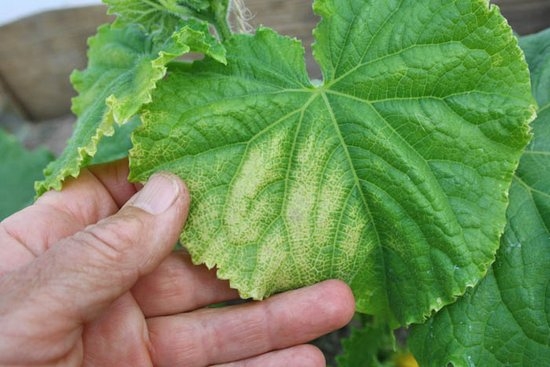
Manure virtually eliminates the possibility of an overdose of nutrients:
- applied dry and dug up with soil during planting;
- laid along the bed, providing top dressing at each watering;
- make a liquid top dressing: it is enough to pour water and let it brew for several days, after straining, water the culture - heals yellow leaves well, over time the tops acquire a healthy green color.
What to do with tops
Each gardener solves this issue in his own way:
- While the stems and leaves are still wet, it is helpful to have a compost pit or container. In a warm and humid place, the tops decompose and provide an excellent organic fertilizer. Sometimes it can take a whole season. The finished mass is laid under future beds and dug up.
- The tops of legumes (peas, beans), carrots and beets are especially appreciated. You can let it dry or grind it fresh. Dig up with the soil. Cucumbers or tomatoes will grow well in this place next season.
- Ash is an excellent fertilizer for most crops. When burning tops, we not only get the basis for feeding the entire garden, but also get rid of various pests and weed seeds. Insect buds also make this list. For example, it is better to burn the foliage of an apple or pear tree that has dried and turned white, since it contains a large number of pests. This will heal the whole garden.
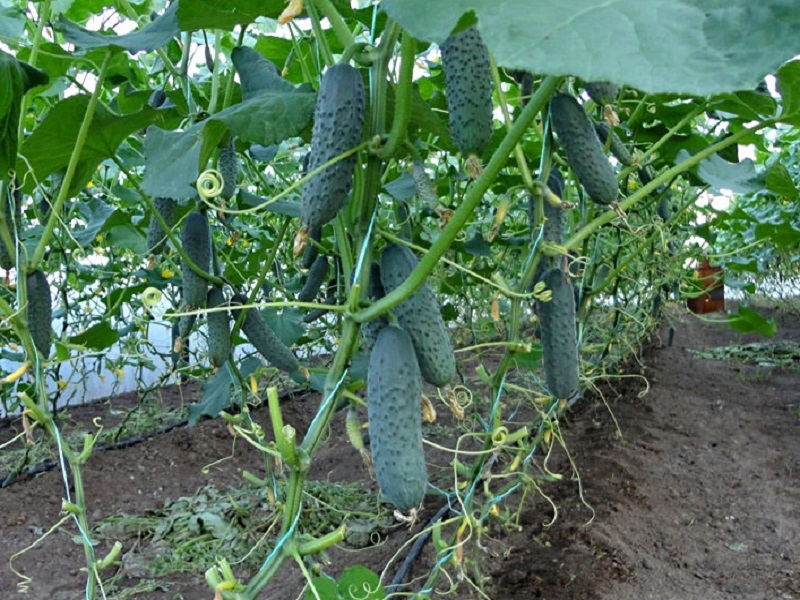
Sometimes at the summer cottage you can see a large plastic or metal barrel. The reasons why summer residents keep a container on their site are quite simple: so-called barrel cucumbers are grown here. During the season, various tops from grass or weeds are laid in it. In the spring, add earth with humus and plant cucumbers, which give a stable ovary and develop rapidly.
To prevent the seedlings from turning yellow, the rims of the metal barrel are insulated. When in contact with them, the plant can get burned. The seedlings hang from the edges of the barrel and feel at ease in the fresh air.
It is recommended to install the barrel on the sunny side, the main thing is to carefully monitor the development of the plant so as not to get burned areas. The processes with the release of heat warm up the root system during the cool part of the day. Unlike indoor crops, this planting method offers certain advantages.
Fresh produce from the garden has a special, unique taste. It seems that vegetables melt in your mouth, the body gladly accepts natural food. Self-grown products are much tastier than store-bought ones. They are quickly absorbed, heal every cell, bring health and creative longevity to life.
